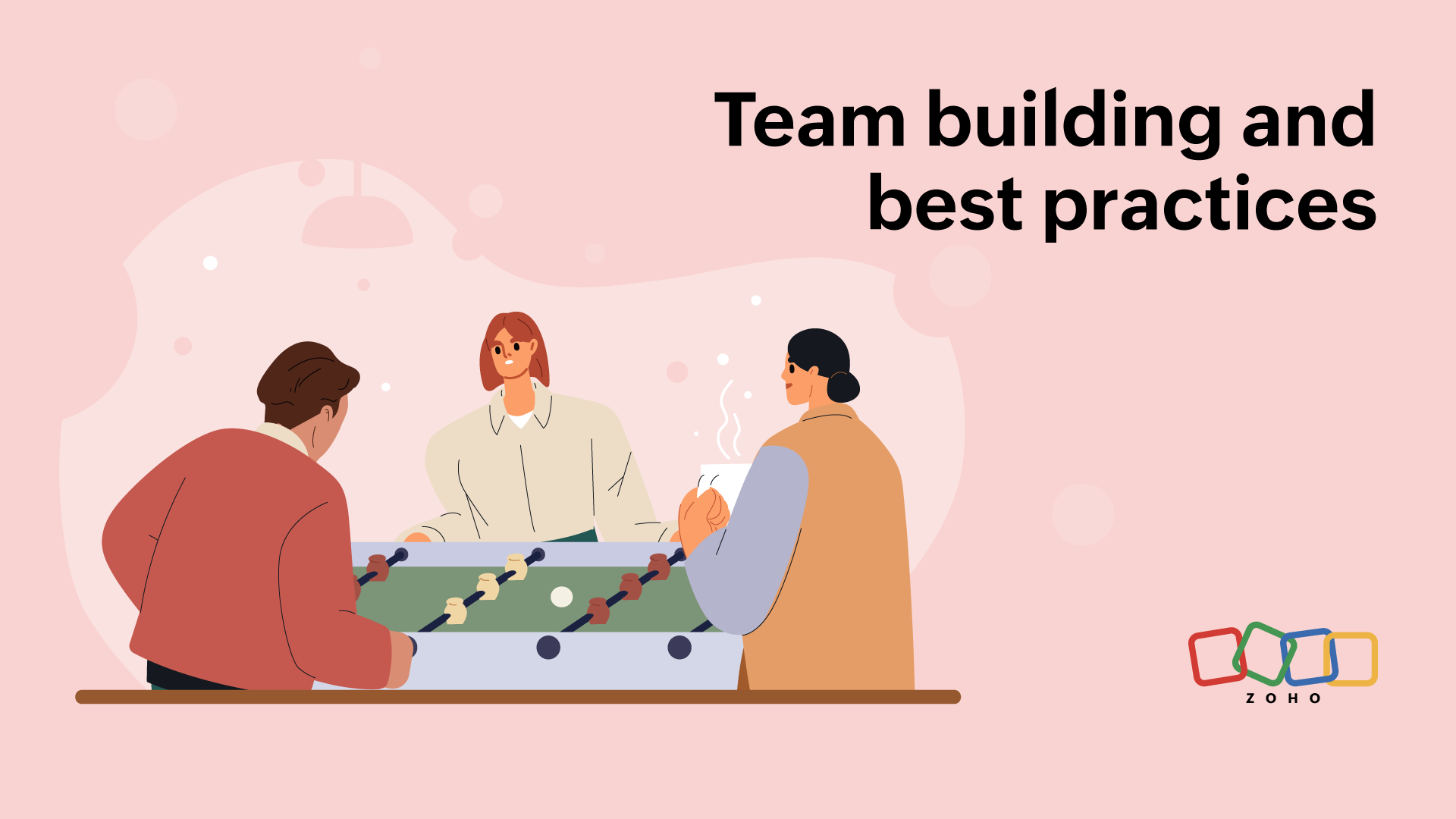- HOME
- All Products
- Collaboration
- Team building and best practices
Team building and best practices
- Published : July 4, 2024
- Last Updated : October 17, 2024
- 420 Views
- 5 Min Read
In the modern workplace, teamwork is a vital component that can make or break a company's success. As a manager or team leader, understanding the art of building cohesive and high-performing teams is an invaluable skill
However, team building is more than just a series of activities; it’s about fostering relationships, enhancing communication, and building trust.
Below, we look at the crucial role of team building in driving success, powerful strategies for cultivating positive team dynamics, and some best practices for managers to unite and inspire their teams.

Understanding team building
Team building is simply the process of bringing individuals together and enabling a collaborative environment where they can work effectively as a cohesive unit. It involves a range of activities and strategies—both structured and casual—designed to enhance communication, build trust, and promote a shared understanding and sense of belonging among team members.
Examples of team-building activities include problem-solving drills, trust-building exercises, social events, and so on. Each of these activities is designed to target specific goals and objectives.
When executed properly, team building offers several benefits, including:
Improved communication and collaboration: Effective team-building activities help break down communication barriers and facilitate better coordination among team members, leading to more efficient collaboration and increased productivity.
Increased trust and understanding: Engaging in team-building exercises allows team members to know each other better, share their perspectives, and develop a deeper understanding and appreciation for one another's strengths, weaknesses, and work styles.
Enhanced problem-solving and decision-making: When team members trust and understand each other, they’re more likely to actively participate in problem-solving and decision-making processes.
Boosted morale and job satisfaction: Effective team-building activities can help team members feel valued, appreciated, and connected to their colleagues and the organization.
How to build team morale and enhance cohesion
Contrary to popular belief, you don’t have to be a master of social interaction to radiate warmth and trust throughout your team. Instead of relying on expensive consultants and self-help books, you can bring your team together if you:
Encourage open communication and feedback
Every successful team is founded on open and transparent communication. Encourage team members to share their ideas, issues, and feedback openly. Implement regular team meetings, one-on-one check-ins, and anonymous feedback channels to ensure that everyone's voice is heard and valued, without the fear of judgment.
Promote teamwork and collaboration
Teamwork and collaboration are crucial for achieving collective goals. Make it a habit for your team members to work together on projects, share knowledge and resources, and support each other's efforts. Consider implementing cross-functional teams or rotating team assignments to foster collaboration and break down silos.
Another good way to enhance collaboration is to invest in collaboration software with capabilities like PDF conversion, real-time editing, or improved messaging solutions. These tools facilitate instant and transparent communication, allowing team members to provide contextual feedback directly on documents and collaborate simultaneously, reducing delays and increasing productivity.
Recognize and appreciate individual contributions
Everyone likes to feel valued and appreciated for their hard work and contributions. Implement a recognition program that celebrates individual achievements, milestones, and successes. This will not only boost morale but also reinforce the desired behaviors and set a positive example for the team.
Foster a positive and supportive work environment
A positive and supportive work environment is crucial for team morale and cohesion. Encourage a culture of respect, empathy, and inclusiveness, where team members feel comfortable being themselves and expressing their ideas without fear of judgment or retaliation. Celebrate team successes and encourage social interactions to build camaraderie.
Provide opportunities for growth and development
Investing in the growth and development of team members not only benefits the individuals but also strengthens the team as a whole. Provide training opportunities, mentorship programs, and opportunities for stretch assignments that challenge and empower team members to reach their full potential.
Address conflicts and facilitate conflict resolution
Conflicts are inevitable in any team setting, but how they’re handled can make or break team cohesion. Encourage open and respectful dialogue, actively listen to all perspectives, and cultivate a culture of conflict resolution rather than conflict avoidance. Implement mediation processes and provide training on effective conflict management techniques.
Best practices for effective team building
Beyond the strategies we’ve covered above, you should rely on these tried-and-tested methods.
Lead by example
As a good manager, your actions and behaviors set the tone for the entire team. Leading by example means you have to demonstrate the values and attitudes you want to see in your team members.
Be respectful, communicative, and collaborative in your interactions. Likewise, it’s your responsibility to embrace a growth mindset and facilitate continuous learning. When team members see you embodying the desired traits, they’re more likely to follow suit.
Leading by example also means knowing when you’re not wanted anymore and when it’s time to depart from the role. Whether you’re a startup founder, CEO, or manager, it’s imperative to recognize when your leadership might be holding the team back or when fresh perspectives are needed to drive the team forward. This self-awareness and readiness to step aside can sometimes be the ultimate demonstration of leading by example.
Regular check-ins
Regular one-on-one and team meetings are essential for gauging team morale, addressing concerns, and fostering open communication. Schedule regular check-ins with individual team members to understand their challenges, successes, and areas for growth.
Additionally, use team meetings to celebrate achievements, discuss ongoing projects, and gather feedback. These regular touchpoints help build trust, strengthen relationships, and ensure everyone is aligned and working towards common goals.
Facilitate team-building activities
Intentionally plan and facilitate team-building activities that align with your team's needs and goals. These activities can range from indoor problem-solving challenges to outdoor adventure experiences.
The key is to choose activities that promote collaboration, communication, trust-building, and bonding among team members. Ensure that the activities are inclusive, engaging, and allow for personal growth and team development.
Promote inclusivity and diversity
Purposefully create an inclusive and diverse team environment where all members feel valued, respected, and empowered to contribute. Embrace diverse perspectives, backgrounds, and experiences to be able to innovate and solve problems more creatively.
You should also actively listen to all team members, celebrate their unique strengths, and provide equitable opportunities for growth and development.
Provide clear goals and expectations
Effective team building requires clear communication of goals, expectations, and roles. It is your responsibility to make every team member understand the overarching objectives. At the same time, they should know their individual responsibilities and contributions.
Regularly revisit goals and realign with them, celebrate achievements, and adjust your course as needed. Clear communication and shared understanding help synchronize team efforts and prevent misunderstandings or conflicts.
Wrapping up
At the end of the day, the success of any organization lies in the strength and cohesion of its teams. A group of individuals working in silos, plagued by miscommunication and lack of trust, can never achieve the same level of success as a well-oiled team that operates as a unified force.
By investing in team-building through the strategies we’ve shared here, you not only enhance team dynamics but also boost morale and job satisfaction, leading to higher productivity and a more positive work culture.
 Gary Stevens
Gary StevensGary Stevens is the CTO of Hosting Canada, a website that provides expert reviews on hosting services and helps readers build online businesses and blogs. Gary specializes in topics on cloud technology, thought leadership, and collaboration at work.











